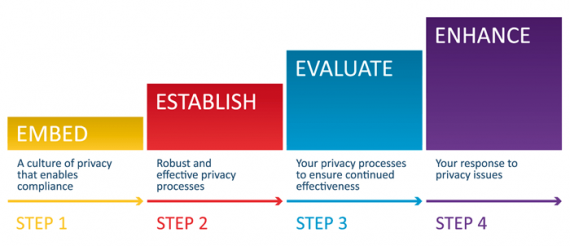-
On this page
Publication date: 16 May 2016
This template is designed for organisations. For agencies, see PMPs in Australian Government Agencies Privacy Code.
The Office of the Australian Information Commissioner’s (OAIC) Privacy management framework (Framework) outlines steps to take to meet your ongoing compliance obligations under Australian Privacy Principle (APP) 1.2. A key tool to help you meet these requirements is to develop and implement a privacy management plan. A privacy management plan is a document that identifies specific, measurable goals and targets that identify how you will implement the four steps outlined in the Framework.
This template is designed to help you develop a privacy management plan for your entity. Which commitments you implement within each step, and who performs these, will depend upon your particular circumstances, including your entity’s size, resources and business model.
You may be able to adapt this template to include specific details around how you intend to implement each commitment. Alternatively, it could be appropriate to specify these details in a separate project plan, dependant on the size and scale of the relevant commitment.

Step 1 — Embed: a culture of privacy that enables compliance
Action | Person responsible | Due | Status |
|---|---|---|---|
Adopt a ‘privacy by design’ approach (see the Guide to undertaking privacy impact assessments) | |||
Assign key roles and responsibilities for privacy management | |||
Assign staff responsibility for managing privacy | |||
Create reporting mechanisms that ensure senior management are routinely informed about privacy issues | |||
Ensure staff understand their privacy obligations and the roles of the OAIC |
Step 2 — Establish: robust and effective privacy practices, procedures and systems
Action | Person responsible | Due | Status |
|---|---|---|---|
Keep information about your business’s personal information holdings (including the type of information you hold and where it is held) up to date | |||
Develop and maintain processes around the handling of personal information prior to collection, while personal information is held and once it is no longer needed (see the Australian Privacy Principles guidelines) | |||
Integrate privacy into staff training and induction processes (see the OAIC’s privacy training resources) | |||
Develop and implement a clearly expressed and up to date privacy policy (see the Guide to developing an APP privacy policy) | |||
Implement risk management processes to identify, assess and manage privacy risks across the business (see the Guide to undertaking privacy impact assessments) | |||
Establish processes for receiving and responding to privacy enquiries and complaints (see Handling privacy complaints) | |||
Establish processes that allow individuals to promptly and easily access and correct their personal information (see more on Access and Correction) | |||
Create a data breach response plan (see Data breach preparation and response) |
Step 3 — Evaluate: your privacy practices, procedures and systems to ensure continued effectiveness
Action | Person responsible | Due | Status |
|---|---|---|---|
Regularly monitor and review privacy processes, policies and notices | |||
Document compliance with privacy obligations, including keeping records on privacy process reviews, breaches and complaints | |||
Measure your performance against this privacy management plan | |||
Create channels for staff and customers to provide feedback on privacy processes |
Step 4 — Enhance: your response to privacy issues
Action | Person responsible | Due | Status |
|---|---|---|---|
Use the results of evaluations to make changes to practices, procedures and systems to improve privacy processes | |||
Have your privacy processes externally assessed/audited to identify areas for improvement | |||
Keep up to date with issues and developments in privacy law and changing legal obligations | |||
Monitor and address new security risks and threats | |||
Examine and address the privacy implications, risks and benefits of new technologies. Consider implementing privacy enhancing technologies that allow you to minimise and better manage the personal information you handle | |||
Introduce initiatives that promote good privacy standards in your business practices | |||
Participate in Privacy Awareness Week and other privacy events |

